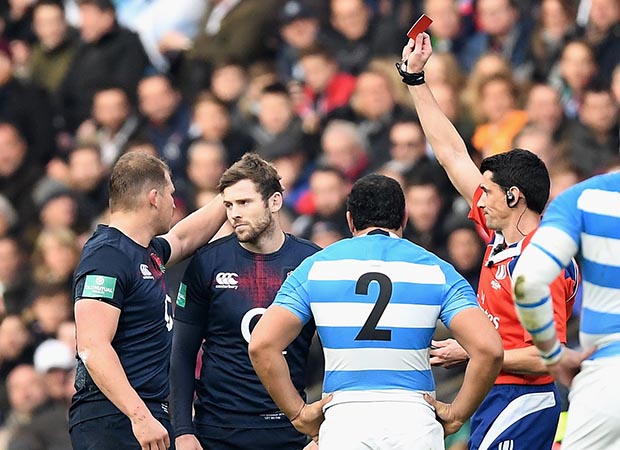 The game is never short of talking points, and refereeing is facing some serious challenges going into 2017. After my 43 years of involvement with Rugby Union – since the age of seven – nothing has changed in the sense that referees are still the guardians of the game.
The game is never short of talking points, and refereeing is facing some serious challenges going into 2017. After my 43 years of involvement with Rugby Union – since the age of seven – nothing has changed in the sense that referees are still the guardians of the game.
It's not an easy job – and if you think it is, have a go. Whether it is at mini rugby level, or even tag rugby, it's often a thankless task. However, it's always worth reminding ourselves that without referees we don't have a game, and in 2017 nothing has changed in that regard.
What has changed is that there is more and more pressure being exerted on referees because of the microscopic analysis they are under from all quarters, whether it is assessors, coaches, the media, or players. Given that they are professional at the elite end they are going to be under scrutiny, and most of that is fair enough.
Set against that, with referees being analysed like never before, they are also being asked to adapt to changes like never before. Their lives are made more difficult because every season it seems there are so many law amendments.
Maybe that's why there are still so few former top players going into refereeing after their playing careers finish.
What we cannot escape is that the way the game is refereed is critical to our enjoyment of it, either as players or spectators – and the old adage is that the less you notice the referee, the better the game is. I believe that still holds true, and that referees have to respond to that despite the difficulties they face.
The latest law change, being brought in mid-season, is that players must observe a tackle line below the shoulders. It's likely we will see more penalties, as well as red and yellow cards, before players adapt to it, and it will spotlight the role of the referee even more.
Whichever way you look at it, policing tackles that ride above the shoulder line will be difficult because of the different heights and angles players take in this split-second before going into contact.
Where Elliot Daly's upending offence against Argentina in the autumn series was a reckless misjudgement, and there could not be too many arguments with the straight red he was given, there is so much that is ambiguous in contact areas.
That is why, while the new law is well-intentioned, referees will use their own discretion. For instance, just as defensive players instinctively reach out towards a pass to stop it beating them, they do the same when they are going the wrong way as an attacker changes direction sharply to step inside them. The reflex is to stick out your arm and reach back to grab them. However, if the attacking player dips low and you get him around the neck, is that reckless or accidental or neither? Is it a free-kick, a penalty, or a card?
These days decisions over foul play almost always involve the TMO. Although TMOs are meant to be advisory – and it is still the referee who makes the final decision – sometimes there are differences of opinion which can make the referee's job even harder. Having that other official's thoughts and interpretations on air makes referees hesitate more.
Something I do not understand is why late tackles are shown in slow-motion. You can only see if it is a late tackle when you watch it in real time, because that is how it happened.
While I understand how difficult elite refereeing is, and appreciate that they are professionals who train hard and spend hours on analysis and feedback, I also have this strong sense that in some respects they do not help themselves.
Here's why. In every match, every week, there will be a crooked feed. Why is that? The laws are clear, but instead we have scrum-halves allowed to put the ball into the second row, and hookers who never learn how to hook, because they don't have to.
The reality is that this is a joke which elite referees have allowed, and it has undermined them as much as it has undermined the scrum as a contest. What is the point of having a scrum if you allow crooked feeds? The scrum is a great and important part of the game, but if the rules governing it are ignored by referees why not ignore every other law in the book?
Players and fans ask, “Why did you let that go, and not this?”. It means referees have opened the door to a conversation that no one should be having. The straight put-in is so easy to apply that it is also so obvious when referees do not do so. It is clear for everybody to see – and it is the starting point for the critique of everything else referees do.
Even with the half step the scrum-half is now allowed to take toward his own side of the tunnel crooked feeds have not stopped, even though there is no need for them!
What we need at elite level is that every referee is very good at the job, and understands that while there is discretion in some areas – like contact – there are certain main laws that simply have to be applied consistently.
Crooked feeds will only happen if referees do not apply the law. The same applies with pushing before the ball is in at the scrum. If it is against the law, penalise it, and players who have developed bad habits will soon learn. There is no discretion in these scrum laws as far as I am aware.
Referees should also be more aware of props getting their feet in positions which make a scrum more likely to collapse. Why do so many modern props have their feet square, rather than having one leg forward?
Where referees do have discretion is in areas such as the advantage law, and how they communicate with players. During my playing days referees would give the team in possession a bit of time to play the advantage, and the length of advantage was pretty consistent from all referees. It was nothing like it is now where they give you any number of phases.
As a player all you want to know is where you are with the referee. In the past referees did not speak to players much, and when they did it was almost always to the captain. It was pretty cut and dried, whereas these days there is too much chat in the game. You can hear it over the ref-link, and whether at the breakdown or the set-piece there are always players indicating opposition infringements to the referee and his assistants.
Some won't allow it, but others do. You also see a lot of inconsistency at the tackle, especially when a defender tackles and then attempts to jackal the ball. Too often the jackaling player touches the ground first so that he is not supporting his own weight. That has to be penalised and taken out of the game.
Then there's the new tolerance among referees for forward passes. In the past when the ball travelled forwards it was a forward pass, but now the picture is more confused because of a clause about whether the passer's hands are pointing forwards or backwards. To most observers the new ruling is as clear as mud.
We still have a wonderful game, but the guy in the middle has to apply the laws, and the more consistently they are applied the better the game will be.


























